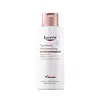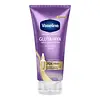Eucerin Spotless Brightening Skin Tone Perfecting Body Lotion Versus Vaseline Healthy Bright Gluta Hya Serum Burst Lotion Spotless Glow
What's inside
What's inside
 Key Ingredients
Key Ingredients

 Benefits
Benefits

 Concerns
Concerns

 Ingredients Side-by-side
Ingredients Side-by-side

Water
Skin ConditioningGlycerin
HumectantAlcohol Denat.
AntimicrobialDiisopropyl Adipate
EmollientButylene Glycol Dicaprylate/Dicaprate
EmollientC12-15 Alkyl Benzoate
AntimicrobialCetearyl Alcohol
EmollientDibutyl Adipate
EmollientDistarch Phosphate
AbsorbentGlyceryl Stearate
EmollientIsobutylamido Thiazolyl Resorcinol
BleachingSodium Hyaluronate
HumectantGlycyrrhiza Inflata Root Extract
Skin ConditioningXanthan Gum
EmulsifyingSodium Stearoyl Glutamate
CleansingTocopheryl Acetate
AntioxidantCitric Acid
BufferingSodium Chloride
MaskingTrisodium EDTA
Ethylhexylglycerin
Skin ConditioningPhenoxyethanol
PreservativeParfum
MaskingWater, Glycerin, Alcohol Denat., Diisopropyl Adipate, Butylene Glycol Dicaprylate/Dicaprate, C12-15 Alkyl Benzoate, Cetearyl Alcohol, Dibutyl Adipate, Distarch Phosphate, Glyceryl Stearate, Isobutylamido Thiazolyl Resorcinol, Sodium Hyaluronate, Glycyrrhiza Inflata Root Extract, Xanthan Gum, Sodium Stearoyl Glutamate, Tocopheryl Acetate, Citric Acid, Sodium Chloride, Trisodium EDTA, Ethylhexylglycerin, Phenoxyethanol, Parfum
Water
Skin ConditioningEthylhexyl Methoxycinnamate
UV AbsorberNiacinamide
SmoothingGlycerin
HumectantAstaxanthin
Skin ConditioningHaematococcus Pluvialis Extract
AntioxidantSodium Acetylated Hyaluronate
HumectantSodium Hyaluronate
HumectantSodium Hyaluronate Crosspolymer
HumectantHydrolyzed Sodium Hyaluronate
Skin ConditioningButyl Methoxydibenzoylmethane
UV AbsorberRetinyl Palmitate
Skin ConditioningHelianthus Annuus Seed Oil
EmollientCystine
MaskingGlycine
BufferingSodium PCA
HumectantGlutathione
Hydrolyzed Collagen
EmollientPetrolatum
EmollientDimethicone
EmollientCyclopentasiloxane
EmollientAcrylates/C10-30 Alkyl Acrylate Crosspolymer
Emulsion StabilisingPhenoxyethanol
PreservativeTriethanolamine
BufferingMethylparaben
PreservativePropylparaben
PreservativeParfum
MaskingPotassium Hydroxide
BufferingStyrene/Acrylates Copolymer
Disodium EDTA
Coco-Glucoside
CleansingBenzoic Acid
MaskingCitric Acid
BufferingAcetyl Hexapeptide-8
HumectantCaprylic/Capric Triglyceride
MaskingTocopherol
AntioxidantBHT
AntioxidantEthylhexylglycerin
Skin ConditioningCyclodextrin
AbsorbentPentylene Glycol
Skin ConditioningPotassium Carbonate
BufferingPotassium Chloride
Sodium Benzoate
MaskingCaprylyl Glycol
EmollientCI 77489
Cosmetic ColorantWater, Ethylhexyl Methoxycinnamate, Niacinamide, Glycerin, Astaxanthin, Haematococcus Pluvialis Extract, Sodium Acetylated Hyaluronate, Sodium Hyaluronate, Sodium Hyaluronate Crosspolymer, Hydrolyzed Sodium Hyaluronate, Butyl Methoxydibenzoylmethane, Retinyl Palmitate, Helianthus Annuus Seed Oil, Cystine, Glycine, Sodium PCA, Glutathione, Hydrolyzed Collagen, Petrolatum, Dimethicone, Cyclopentasiloxane, Acrylates/C10-30 Alkyl Acrylate Crosspolymer, Phenoxyethanol, Triethanolamine, Methylparaben, Propylparaben, Parfum, Potassium Hydroxide, Styrene/Acrylates Copolymer, Disodium EDTA, Coco-Glucoside, Benzoic Acid, Citric Acid, Acetyl Hexapeptide-8, Caprylic/Capric Triglyceride, Tocopherol, BHT, Ethylhexylglycerin, Cyclodextrin, Pentylene Glycol, Potassium Carbonate, Potassium Chloride, Sodium Benzoate, Caprylyl Glycol, CI 77489
Ingredients Explained
These ingredients are found in both products.
Ingredients higher up in an ingredient list are typically present in a larger amount.
Citric Acid is an alpha hydroxy acid (AHA) naturally found in citrus fruits like oranges, lemons, and limes.
Like other AHAs, citric acid can exfoliate skin by breaking down the bonds that hold dead skin cells together. This helps reveal smoother and brighter skin underneath.
However, this exfoliating effect only happens at high concentrations (20%) which can be hard to find in cosmetic products.
Due to this, citric acid is usually included in small amounts as a pH adjuster. This helps keep products slightly more acidic and compatible with skin's natural pH.
In skincare formulas, citric acid can:
While it can provide some skin benefits, research shows lactic acid and glycolic acid are generally more effective and less irritating exfoliants.
Most citric acid used in skincare today is made by fermenting sugars (usually from molasses). This synthetic version is identical to the natural citrus form but easier to stabilize and use in formulations.
Read more about some other popular AHA's here:
Learn more about Citric AcidEthylhexylglycerin (we can't pronounce this either) is commonly used as a preservative and skin softener. It is derived from glyceryl.
You might see Ethylhexylglycerin often paired with other preservatives such as phenoxyethanol. Ethylhexylglycerin has been found to increase the effectiveness of these other preservatives.
Glycerin is already naturally found in your skin. It helps moisturize and protect your skin.
A study from 2016 found glycerin to be more effective as a humectant than AHAs and hyaluronic acid.
As a humectant, it helps the skin stay hydrated by pulling moisture to your skin. The low molecular weight of glycerin allows it to pull moisture into the deeper layers of your skin.
Hydrated skin improves your skin barrier; Your skin barrier helps protect against irritants and bacteria.
Glycerin has also been found to have antimicrobial and antiviral properties. Due to these properties, glycerin is often used in wound and burn treatments.
In cosmetics, glycerin is usually derived from plants such as soybean or palm. However, it can also be sourced from animals, such as tallow or animal fat.
This ingredient is organic, colorless, odorless, and non-toxic.
Glycerin is the name for this ingredient in American English. British English uses Glycerol/Glycerine.
Learn more about GlycerinParfum is a catch-all term for an ingredient or more that is used to give a scent to products.
Also called "fragrance", this ingredient can be a blend of hundreds of chemicals or plant oils. This means every product with "fragrance" or "parfum" in the ingredients list is a different mixture.
For instance, Habanolide is a proprietary trade name for a specific aroma chemical. When used as a fragrance ingredient in cosmetics, most aroma chemicals fall under the broad labeling category of “FRAGRANCE” or “PARFUM” according to EU and US regulations.
The term 'parfum' or 'fragrance' is not regulated in many countries. In many cases, it is up to the brand to define this term.
For instance, many brands choose to label themselves as "fragrance-free" because they are not using synthetic fragrances. However, their products may still contain ingredients such as essential oils that are considered a fragrance by INCI standards.
One example is Calendula flower extract. Calendula is an essential oil that still imparts a scent or 'fragrance'.
Depending on the blend, the ingredients in the mixture can cause allergies and sensitivities on the skin. Some ingredients that are known EU allergens include linalool and citronellol.
Parfum can also be used to mask or cover an unpleasant scent.
The bottom line is: not all fragrances/parfum/ingredients are created equally. If you are worried about fragrances, we recommend taking a closer look at an ingredient. And of course, we always recommend speaking with a professional.
Learn more about ParfumPhenoxyethanol is a preservative that has germicide, antimicrobial, and aromatic properties. Studies show that phenoxyethanol can prevent microbial growth. By itself, it has a scent that is similar to that of a rose.
It's often used in formulations along with Caprylyl Glycol to preserve the shelf life of products.
Sodium Hyaluronate is hyaluronic acid's salt form. It is commonly derived from the sodium salt of hyaluronic acid.
Like hyaluronic acid, it is great at holding water and acts as a humectant. This makes it a great skin hydrating ingredient.
Sodium Hyaluronate is naturally occurring in our bodies and is mostly found in eye fluid and joints.
These are some other common types of Hyaluronic Acid:
Learn more about Sodium HyaluronateWater. It's the most common cosmetic ingredient of all. You'll usually see it at the top of ingredient lists, meaning that it makes up the largest part of the product.
So why is it so popular? Water most often acts as a solvent - this means that it helps dissolve other ingredients into the formulation.
You'll also recognize water as that liquid we all need to stay alive. If you see this, drink a glass of water. Stay hydrated!
Learn more about Water